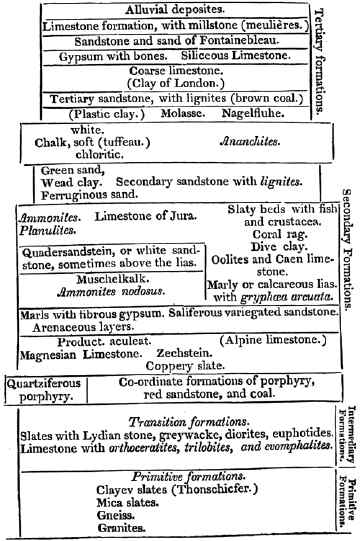 |
a-kin to those of the present day; those land animals
and mollusca, and other fresh-water animals, also
unknown, which next occupy the places, to be again
displaced, but by mollusca, and other animals similar
to those of our own seas; the relations of these various
beings with the plants, whose remains accompany
theirs; the relations of these two kingdoms with the
mineral layers which contain them; the more or less
their uniformity with one another in different basins;
all these are a series of phenomena which appears to
me to call imperiously for the profound attention of
philosophers.
 Made interesting by the variety of the productions Made interesting by the variety of the productions
of the partial or universal revolutions of this epoch,
and by the abundance of the various species which
alternately figure on the stage, this study is divested of
the dryness of that of the primordial for mations, and
does not, like it, plunge itself into hypotheses. The
facts are so close, so curious, and so evident, that they
suffice in a measure for the most ardent imagination;
and the conclusions which they arrive at from time to
time, however scrupulous the observer maybe; not
having any thing in definite, at the same time have
nothing arbitrary. Finally, it is in the events which are
nearer to our times that we can hope to find any traces
of the more ancient events and their causes, if it be
indeed allowed, after so many trials, to flatter
ourselves with such a hope.
 These ideas have beset, I may say, have tormented These ideas have beset, I may say, have tormented
me, whilst I have been engaged in making researches
amongst fossil bones, the results of which I have lately
made public; researches which only comprise so small
a portion of these phenomena of the last age but one of
the earth, and which, notwithstanding, are united to all
the others in an intimate
|


 1-10
11-20
21-30
31-40
41-50
51-60
61-70
71-80
81-90
91-100
101-110
111-120
121-130
131-140
141-150
151-160
161-170
171-180
181-190
191-200
201-210
211-220
221-230
231-240
241-250
251-260
1-10
11-20
21-30
31-40
41-50
51-60
61-70
71-80
81-90
91-100
101-110
111-120
121-130
131-140
141-150
151-160
161-170
171-180
181-190
191-200
201-210
211-220
221-230
231-240
241-250
251-260


![[made with GoClick]](imgs/goclick.gif)